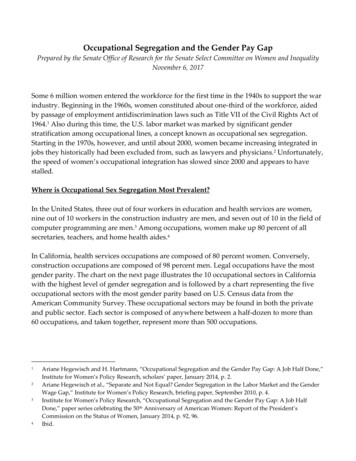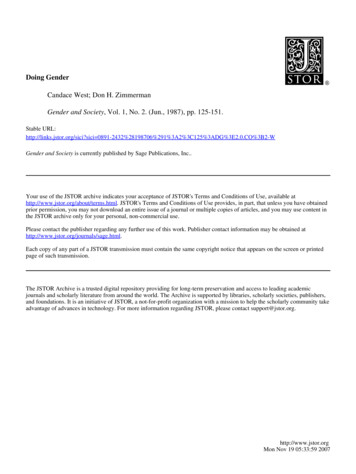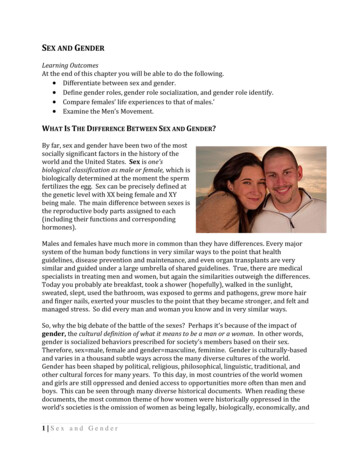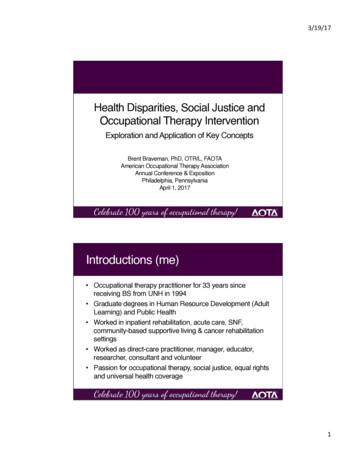
Transcription
Occupational Segregation and the Gender Pay GapPrepared by the Senate Office of Research for the Senate Select Committee on Women and InequalityNovember 6, 2017Some 6 million women entered the workforce for the first time in the 1940s to support the warindustry. Beginning in the 1960s, women constituted about one-third of the workforce, aidedby passage of employment antidiscrimination laws such as Title VII of the Civil Rights Act of1964.1 Also during this time, the U.S. labor market was marked by significant genderstratification among occupational lines, a concept known as occupational sex segregation.Starting in the 1970s, however, and until about 2000, women became increasing integrated injobs they historically had been excluded from, such as lawyers and physicians.2 Unfortunately,the speed of women’s occupational integration has slowed since 2000 and appears to havestalled.Where is Occupational Sex Segregation Most Prevalent?In the United States, three out of four workers in education and health services are women,nine out of 10 workers in the construction industry are men, and seven out of 10 in the field ofcomputer programming are men.3 Among occupations, women make up 80 percent of allsecretaries, teachers, and home health aides.4In California, health services occupations are composed of 80 percent women. Conversely,construction occupations are composed of 98 percent men. Legal occupations have the mostgender parity. The chart on the next page illustrates the 10 occupational sectors in Californiawith the highest level of gender segregation and is followed by a chart representing the fiveoccupational sectors with the most gender parity based on U.S. Census data from theAmerican Community Survey. These occupational sectors may be found in both the privateand public sector. Each sector is composed of anywhere between a half-dozen to more than60 occupations, and taken together, represent more than 500 occupations.1234Ariane Hegewisch and H. Hartmann, “Occupational Segregation and the Gender Pay Gap: A Job Half Done,”Institute for Women’s Policy Research, scholars’ paper, January 2014, p. 2.Ariane Hegewisch et al., “Separate and Not Equal? Gender Segregation in the Labor Market and the GenderWage Gap,” Institute for Women’s Policy Research, briefing paper, September 2010, p. 4.Institute for Women’s Policy Research, “Occupational Segregation and the Gender Pay Gap: A Job HalfDone,” paper series celebrating the 50th Anniversary of American Women: Report of the President’sCommission on the Status of Women, January 2014, p. 92, 96.Ibid.
A few examples of the occupations within each of these sectors are: health services—nursing aides andphlebotomists; personal care—funeral directors and hairdressers; medical—physicians and medical recordtechnicians; office support—secretaries and proofreaders; education—preschool/kindergarten teachers andlibrarians; transportation/materials—aircraft pilots and subway workers; military—tactical operations leaders andair/weapons specialists; extraction—earth drillers and explosives workers; repair—locksmiths and automotiveglass installers; and construction—construction trades helpers and carpenters.A few examples of the occupations within each of these sectors are: sales—cashiers and real estate brokers;finance— accountants and tax collectors; legal—paralegals and lawyers; science—astronomers and psychologists;and business—event planners and compliance officers.2
What Explains Occupational Sex Segregation?The literature identifies a number of factors that contribute to occupational segregation basedon sex. This paper addresses one such factor- implicit bias- that has drawn increasingattention. Implicit bias involves “attitudes or stereotypes that affect our understanding,actions, and decisions in an unconscious manner.”5 According to a body of scholarly research,the unconscious attitudes we hold about other people often are based on categories such asrace, gender, age, or ethnicity. Studies suggest implicit bias is pervasive, not necessarily in linewith our declared beliefs, developed early in life, and not fixed.6 Further, implicit bias isexpressed at both an individual and institutional level.Unconscious attitudes based on gender operate in different facets of our society.7 In theemployment context, some argue that gender bias influences occupational choices andpatterns, ultimately limiting women’s economic opportunities. Since the 1980s, a growingbody of research has sought to explain how implicit gender attitudes impact career choice andprogression. Specifically, a number of studies conclude gender bias is a significant contributorto the overrepresentation of men or women in certain occupations.8 The impact of segregationhas long been studied in a number of contexts and has been found to create social inequalityby sorting groups into a dominant or subordinate status.9A few theories seek to explain the link between implicit gender bias and occupationalsegregation. First, a theory grounded in sociology contends the allocation of men and womenin different jobs is a result of long-term exposure to and compliance with cultural beliefsregarding gender appropriate attributes, skills, and occupations. According to this perspective,men are encouraged to pursue occupations that involve masculine stereotypes, skills andauthority, while women are encouraged to pursue occupations associated with feminine56789Kirwan Institute for the Study of Race and Ethnicity, “Understanding Implicit Bias,” Ohio State University,2015, ing-implicit-bias/.Ibid.For this paper, I use the term gender and sex interchangeably with the understanding these labels often arenot binary and may be fluid.Margaret S. Stockdale and J. T. Nadler, “Paradigmatic Assumptions of Disciplinary Research and GenderDisparities: The Case of Occupational Sex Segregation,” Sex Roles: A Journal of Research, vol. 68, 2013,p. 207–15; Catherine R. Dunham, “Third Generation Discrimination: Ripple Effects of Gender Bias in theWorkplace,” Elon University School of Law, August 15, 2017; Vicki Shultz, “Telling Stories About Womenand Work: Judicial Interpretations of Sex Segregation in the Workplace in Title VII Cases Raising the Lack ofInterest Argument,” Harvard Law Review, vol. 103, June 1990, p. 1,749; and Laurie A. Morgan, ”Major Matters:A Comparison of the Within-Major Gender Pay Gap Across College Majors for Early-Career Graduates,”Industrial Relations: A Journal of Economy and Society, vol. 47, no. 4, 2008, p. 626–650.Barbara Reskin, “Sex Segregation in the Workplace,” Annual Review of Sociology, vol. 19, 1993, p. 241.3
stereotypes, skills and traits.10 In addition, while men and women may choose to enter male- orfemale-associated occupations, their choice can be seen as the result of a complex interactionbetween cultural bias, social pressures, and even discrimination.11 These biases and pressuresmay operate over a long period and result from interactions with teachers, peers, family,mentors or role models, coworkers, and employers. As a complex process, occupational choicealso may be influenced by personal interest, skills and abilities, educational opportunities andattainment, and concerns for work-family balance. These factors also can be shaped by ourcultural and social experiences.Drilling this concept down further, sociological research also looks at the impact of women’scollege major choice on career choice and explores the societal pressures influencing collegemajor choice. This research reveals women overwhelming major and graduate in education,psychology, and social work, while men favor engineering, a field with much higher earningpotential.12 In particular, researchers have studied how gendered expectations about women’saptitudes for science and math careers influence their educational, and ultimately, professionalchoices.13 The Organisation for Economic Cooperation and Development (OECD), amultinational economic justice think-tank of which the United States is a participatingmember, surveyed 15-year-olds from 60 countries in 2006 and found only 5 percent of girlscontemplated a career in computing or engineering.14 In addition, in 2012, OECD surveyedparents of 15-year-olds in 10 countries and found parents were more likely to expect theirsons, rather than their daughters, to work in a science, technology, engineering, and math(STEM) field even when their daughters perform at the same level in mathematics.15 The studyconcluded that parental expectations for gender-normative careers can be a factor in theirchildren’s occupational outcomes.101112131415Margaret S. Stockdale and J. T. Nadler, “Paradigmatic Assumptions of Disciplinary Research and GenderDisparities: The Case of Occupational Sex Segregation,” Sex Roles: A Journal of Research, vol. 68, 2013,p. 207–15.Ibid.Anthony P. Carnevale and N. Smith, “Women, Jobs and Opportunity in the 21 st Century,” paper seriescelebrating the 50th Anniversary of American Women: Report of the President’s Commission on the Status ofWomen, 2014, p. 40–41.Jessica Schieder and E. Gould, “Women’s Work and the Gender Pay Gap,” Economic Policy Institute,July 20, 2016, p. 4–5; Catherine Hill and E. Prangley, “Policy, Education, and Social Change: 50 Years ofProgress,” paper series celebrating the 50th Anniversary of American Women: Report of the President’sCommission on the Status of Women, 2014, p. 231–32.Organisation for Economic Cooperation and Development, The ABC of Gender Equality in Education: Aptitude,Behavior, Confidence (Paris: OECD Publishing, 2015), p. 114, e-doing-to-promote-gender-equality-ineducation 9789264229945-10-en.Ibid, p. 139.4
Another major theory linking gender bias to occupational segregation focuses on employers’implicit attitudes about appropriate workplace roles for men and women. This theory positsthat employers contribute to job segregation by exercising their own gender biases in hiring,performance reviews, and promotional practices.16 Hiring practices are influenced by anemployer’s perception of the appropriateness of an individual for a particular job oroccupation, and gender bias in some cases may guide that perception. According to thistheory, engrained assumptions that men are more status-worthy and competent may leademployers to hire women disproportionately into lower-wage and less prestigious positions.17In 2014, women held two-thirds of lower-wage jobs despite representing just under half of theworkforce overall.18Occupational Segregation and the Gender Pay GapA number of studies conclude that sex-based occupational segregation is a major contributorto the pay gap.19 The gender pay gap measures what women are paid relative to men. In theUnited States, as of 2015, women’s median earnings were approximately 40,700, comparedwith 51,200 for men.20 This translates to women making 80 cents for every dollar earned bymen. In California, the gap is somewhat less, with women making 84 cents on the dollar.21The gap persists regardless of a woman’s education level and is the largest overall for womenwith advanced degrees.22 In terms of tangible income, women are losing a little more than16171819202122Margaret S. Stockdale and J. T. Nadler, “Paradigmatic Assumptions of Disciplinary Research and GenderDisparities: The Case of Occupational Sex Segregation,” Sex Roles: A Journal of Research, vol. 68, 2013, p. 213.Cecelia L. Ridgeway and P. England, Sociological Approaches to Sex Discrimination in Employment, SexDiscrimination in the Workplace (MA: Blackwell Publishing, 2007), p. 189–212.Anne Morrison and K. Robbins, “Chartbook: Women in the Low-Wage Workforce May Not Be Who YouThink,” National Women’s Law Center, September 2015, e-workforce-may-not-be-who-you-think/. (For purposes of this report, low-wage jobs are defined as thosethat generally pay 10.50 or less per hour).Francine Blau and L. M. Kahn, “Gender Wage Gap: Extent, Trends, and Explanations,” National Bureau ofEconomic Research, working paper, January 2016; Barbara Reskin, “Sex Segregation in the Workplace,”Annual Review of Sociology, vol. 19, 1993, p. 241; Ariane Hegewisch et al., “Separate and Not Equal? GenderSegregation in the Labor Market and the Gender Wage Gap,” Institute for Women’s Policy Research, briefingpaper, September 2010; and Philip N. Cohen, “Persistence of Gender Segregation at Work,” Sociology Compass,2013, p. 889–99. For more information, also see my April 2017 paper, “What is the Gender Pay or%20website.pdf.American Association of University Women, “Simple Truth About the Gender Pay Gap,” Spring 2017,p. 4.National Partnership for Women and Families, “California Women and the Wage Gap,” fact sheet,April 2016, p. 1, f.Economic Policy Institute, “What is the Gender Pay Gap and is it Real? The Complete Guide to How Womenare Paid Less Than Men, and Why it Can’t be Explained Away,” October 20, 2016, p.18,http://www.epi.org/files/pdf/112962.pdf.5
8,000 annually to the pay gap. An analysis of census pay data for 2014 reveals California’sgender pay gap amounts to 39 billion annually in lost wages for women.23Gender-based occupational segregation contributes to the pay gap because female-dominatedwork pays less overall than male-dominated work both historically and presently.24 Studiesestimate that sex segregation accounts for one-third to 40 percent of the gender pay gap.25 Infact, female-dominated jobs at every skill level—low, medium, and high—are associated withlower median earnings than comparable male-dominated jobs.26 According to 2010 Bureau ofLabor Statistics data, examples of low-skilled female-dominated occupations are home healthaides and housekeeping cleaners; examples of medium-skilled female-dominated occupationsare secretaries and administrative assistants; and examples of high-skilled female-dominatedoccupations are elementary school teachers and registered nurses.27 The share of womenworking in an occupation appears directly correlated to pay. A compelling study of 50 years ofU.S. workforce data found when there is an influx of women into a previously maledominated profession, average wages for the occupation decrease.28—Prepared by Megan Lane232425262728National Partnership for Women and Families, “California Women and the Wage Gap,” fact sheet,April 2016, p. 1 (Census data analyzed is from the American Community Survey One-Year Estimates 2014:Geographies: All States Within United States and Puerto Rico, 2015).Economic Policy Institute, “What is the Gender Pay Gap and is it Real? The Complete Guide to How Womenare Paid Less Than Men, and Why it Can’t be Explained Away,” October 20, 2016; Asaf Levanon, P. England,and P. Allison, “Occupational Feminization and Pay: Assessing Causal Dynamics Using 1950–2000U.S. Census Data,” Journal of Social Forces, vol. 88, no. 2, December 2009, p. 865–892.Francine Blau and L. M. Kahn, “Gender Wage Gap: Extent, Trends, and Explanations,” National Bureau ofEconomic Research, working paper, January 2016 (concluding sex segregation accounts for one-third of thepay gap); and Hilary M. Lips, “Gender Pay Gap: Challenging the Rationalizations: Perceived Equity,Discrimination, and the Limits of Human Capital Models,” Sex Roles: A Journal of Research, vol. 68, no. 3–4,February 2013, p. 169–185 (concluding the segregation factor accounts for approximately 40 percent of thegender pay gap).Ariane Hegewisch et al., “Separate and Not Equal? Gender Segregation in the Labor Market and the GenderWage Gap,” Institute for Women’s Policy Research, briefing paper, September 2010, p. 13.Ibid., p. 8–10.Asaf Levanon, P. England, and P. Allison, “Occupational Feminization and Pay: Assessing Causal DynamicsUsing 1950–2000 U.S. Census Data,” Journal of Social Forces, vol. 88, no. 2, December 2009, p. 865–892.6
Additional ResourcesJessica Pan, “Gender Segregation in Occupations: The Role of Tipping and Social Interactions,”Journal of Labor Economics, vol. 33, no. 2, April 2015, p. 365–408.Trond Petersen and L.A. Morgan, “Separate and Unequal: Occupation-Establishment SexSegregation and the Gender Wage Gap,” American Journal of Sociology, vol. 101, no. 2,September 1995, p. 329–365.Barbara F. Reskin and H.I. Hartmann, Women’s Work, Men’s Work: Sex Segregation on the Job,1st ed. (Washington D.C.: National Academy Press, 1986).Susan Sturm, “Second Generation Employment Discrimination: A Structural Approach,”Columbia Law Review, vol. 101, April 2001, p. 458–568.7
The gender pay gap measures what women are paid relative to men. In the United States, as of 2015, women's median earnings were approximately 40,700, compared with 51,200 for men. 20 . This translates to women making 80 cents for every dollar earned by men. In California, the gap is somewhat less, with women making 84 cents on the dollar. 21










